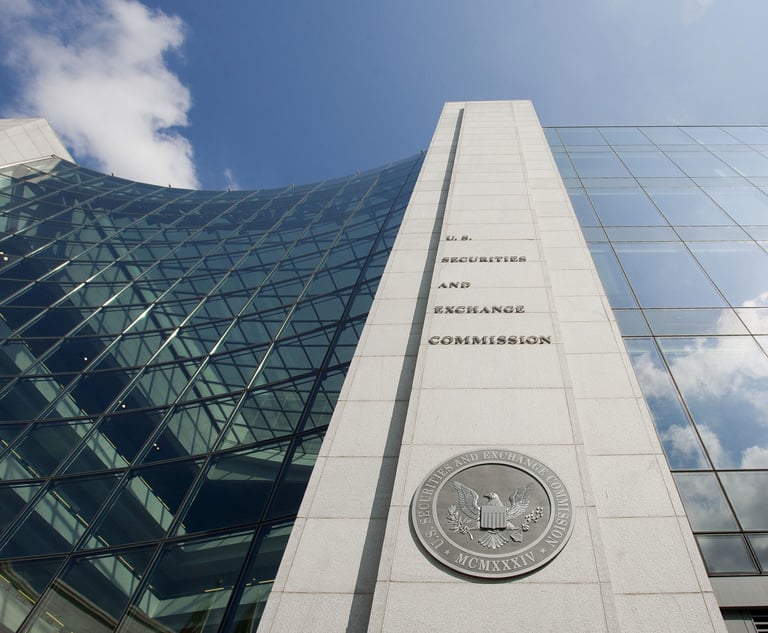Pre-Tax Facts
After decades without change, cafeteria plans experience a makeover.
May 31, 2008 at 08:00 PM
6 minute read
“Stony silence” is probably the best way to describe the corporate community's initial response to the Internal Revenue Service's (IRS) first comprehensive new guidance on “cafeteria plans” since 1984. Cafeteria plans allow employees to pay into certain employee benefits with pre-tax payroll deductions.
“We're not seeing employers taking action,” says Heidi Winzeler, counsel at Osler Hoskin & Harcourt.
While the guidelines represent more of a consolidation than a sea change, they do introduce some significant modifications to existing practices. The regulations now require the existence of a plan document and mandate specific discrimination tests to ensure that highly paid employees do not benefit disproportionately. They also institute a zero-tolerance policy that would make a plan ineligible for preferential tax treatment for any failure to comply with the regulations.
“One wrong move could subject employers and employees to significant tax liabilities,” Winzeler says.
The proposed new guidelines, issued in August 2007, have not yet been released in their final form, and at press time their precise release date was unknown.
The guidelines do provide, however, that employers who conform to the proposals will have a safe harbor even if there are changes in the final rules.
However that may be, the IRS has been firm in its commitment that the final rules will be issued in time to take effect for plan years beginning on or after Jan. 1, 2009.
“But my sense is still that clients are waiting around for the final version,” says Chris Guldberg, a partner at Baker & McKenzie.
Winzeler, who believes changes in the final version will only be technical and cosmetic, says employers shouldn't wait around too long.
The guidance is long and complex and involves revisiting plan documents as well as the formulation and distribution of communications, forms and procedures,” she says.
Zero Tolerance
The greatest urgency arises where employers have no plan document–
a written document setting out the details of the plan.
“Many employers have only summary plan descriptions that are just part of the employee handbook,” says Mark Boxer, a partner with DLA Piper USA. “It's now clear that employers will have to have a specific plan document that is distinct from the summary.”
But even companies with detailed plan documents will have to be careful because the regulations are very specific about what needs to be in the document, such as descriptions of benefits, as well as rules for participation, elections and contributions.
“The requirements are a lot more detailed than they were in the past,” Winzeler says. “So the zero-tolerance policy makes it critical to review existing documents, some of which date back to the 1980s.”
Employers crafting plans will want to look closely at the “prohibited” benefits, which include scholarships, meals and lodging, educational assistance, long-term care benefits, fringe benefits, group term life insurance for family members and coverage for business partners or independent contractors.
They will need to ensure that these benefits are removed from the menu available to participants under the cafeteria plan and decide whether to offer these benefits under a separate benefits plan that offers no tax advantages or remove them entirely.
Here, zero tolerance looms again in the sense that a cafeteria plan that offers any of the “prohibited benefits” will be ineligible for preferential treatment in its entirety.
“There is no leeway for substantial compliance concepts,” Winzeler says.
But determining whether the plan includes prohibited benefits isn't as simple as it may appear. For example, employers will have to ensure that they're not covering U.S. taxpayers in a noncompliant plan outside the U.S.
Coming up with a proper plan document, however, may pale beside the burden of implementing the discrimination testing rules.
Put to the Test
Discrimination rules designed to ensure that highly compensated employees (HCEs) did not benefit disproportionately from the plan have always been in place, but they were confusing and vague.
“Many employers either didn't know they existed or, if they knew, ignored them because no one knew how to apply them,” Winzeler says. “They're much more specific now.”
The new rules require employers to do three mathematical tests annually: a nondiscriminatory eligibility test, based on the classification test found in Code Section 410(b); a contribution and benefits test that compares benefits or contributions for HCEs as a percentage of compensation; and a key employee concentration test to demonstrate that HCEs' nontaxable benefits don't exceed 25 percent of total nontaxable benefits.
Although these rules look much like the testing rules for tax-qualified retirement plans (such as 401(k) plans), employers need to learn the differences. Most importantly, HCEs are not defined the same way as they are under tax qualified plan rules.
“Separate tracking will be required, and there will be administrative challenges in collecting the data and running the tests,” Boxer says.
If a plan doesn't pass discrimination muster, HCEs will be taxed on the highest value of the benefits they could have elected; other employees may be taxed on their actual benefits as if they had elected to take cash.
And just in case anyone's wondering, the IRS will be watching closely.
Pay Attention
“The general expectation is that the issuance of this consolidated regulation will mark a period of increased enforcement activity,” Winzeler says.
And if an IRS audit bears fruit, the consequences will surely extend beyond the monetary penalties imposed.
“Suddenly discovering that the plan is ineligible and that employees will become liable for tax on the benefits received could easily throw a monkey wrench into employees' relations with and confidence in a company,” Boxer says.
There's also the prospect of lawsuits from employees who may take the position that the company was negligent in failing to assure that an alleged
“cafeteria” plan was in compliance with the Code.
What's clear, then, is that many cafeteria plans are due–and perhaps overdue– for a checkup.
This content has been archived. It is available through our partners, LexisNexis® and Bloomberg Law.
To view this content, please continue to their sites.
Not a Lexis Subscriber?
Subscribe Now
Not a Bloomberg Law Subscriber?
Subscribe Now
NOT FOR REPRINT
© 2025 ALM Global, LLC, All Rights Reserved. Request academic re-use from www.copyright.com. All other uses, submit a request to [email protected]. For more information visit Asset & Logo Licensing.
You Might Like
View All
Khan Defends FTC Tenure, Does Not Address Post-Inauguration Plans

Best Practices for Adopting and Adapting to AI: Mitigating Risk in Light of Increasing Regulatory and Shareholder Scrutiny
7 minute read
Crypto Groups Sue IRS Over Decentralized Finance Reporting Rule

SEC Penalizes Wells Fargo, LPL Financial $900,000 Each for Inaccurate Trading Data
Trending Stories
- 1Law Firms Close Southern California Offices Amid Devastating Wildfires
- 2Lawsuit alleges racial and gender discrimination led to an Air Force contractor's death at California airfield
- 3Holland & Knight Picks Up 8 Private Wealth Lawyers in Los Angeles
- 4Khan Defends FTC Tenure, Does Not Address Post-Inauguration Plans
- 5J.D. Vance Campaign Finance Challenge Leads December Supreme Court Petition Roundup
Who Got The Work
Michael G. Bongiorno, Andrew Scott Dulberg and Elizabeth E. Driscoll from Wilmer Cutler Pickering Hale and Dorr have stepped in to represent Symbotic Inc., an A.I.-enabled technology platform that focuses on increasing supply chain efficiency, and other defendants in a pending shareholder derivative lawsuit. The case, filed Oct. 2 in Massachusetts District Court by the Brown Law Firm on behalf of Stephen Austen, accuses certain officers and directors of misleading investors in regard to Symbotic's potential for margin growth by failing to disclose that the company was not equipped to timely deploy its systems or manage expenses through project delays. The case, assigned to U.S. District Judge Nathaniel M. Gorton, is 1:24-cv-12522, Austen v. Cohen et al.
Who Got The Work
Edmund Polubinski and Marie Killmond of Davis Polk & Wardwell have entered appearances for data platform software development company MongoDB and other defendants in a pending shareholder derivative lawsuit. The action, filed Oct. 7 in New York Southern District Court by the Brown Law Firm, accuses the company's directors and/or officers of falsely expressing confidence in the company’s restructuring of its sales incentive plan and downplaying the severity of decreases in its upfront commitments. The case is 1:24-cv-07594, Roy v. Ittycheria et al.
Who Got The Work
Amy O. Bruchs and Kurt F. Ellison of Michael Best & Friedrich have entered appearances for Epic Systems Corp. in a pending employment discrimination lawsuit. The suit was filed Sept. 7 in Wisconsin Western District Court by Levine Eisberner LLC and Siri & Glimstad on behalf of a project manager who claims that he was wrongfully terminated after applying for a religious exemption to the defendant's COVID-19 vaccine mandate. The case, assigned to U.S. Magistrate Judge Anita Marie Boor, is 3:24-cv-00630, Secker, Nathan v. Epic Systems Corporation.
Who Got The Work
David X. Sullivan, Thomas J. Finn and Gregory A. Hall from McCarter & English have entered appearances for Sunrun Installation Services in a pending civil rights lawsuit. The complaint was filed Sept. 4 in Connecticut District Court by attorney Robert M. Berke on behalf of former employee George Edward Steins, who was arrested and charged with employing an unregistered home improvement salesperson. The complaint alleges that had Sunrun informed the Connecticut Department of Consumer Protection that the plaintiff's employment had ended in 2017 and that he no longer held Sunrun's home improvement contractor license, he would not have been hit with charges, which were dismissed in May 2024. The case, assigned to U.S. District Judge Jeffrey A. Meyer, is 3:24-cv-01423, Steins v. Sunrun, Inc. et al.
Who Got The Work
Greenberg Traurig shareholder Joshua L. Raskin has entered an appearance for boohoo.com UK Ltd. in a pending patent infringement lawsuit. The suit, filed Sept. 3 in Texas Eastern District Court by Rozier Hardt McDonough on behalf of Alto Dynamics, asserts five patents related to an online shopping platform. The case, assigned to U.S. District Judge Rodney Gilstrap, is 2:24-cv-00719, Alto Dynamics, LLC v. boohoo.com UK Limited.
Featured Firms
Law Offices of Gary Martin Hays & Associates, P.C.
(470) 294-1674
Law Offices of Mark E. Salomone
(857) 444-6468
Smith & Hassler
(713) 739-1250






